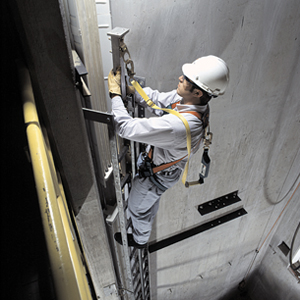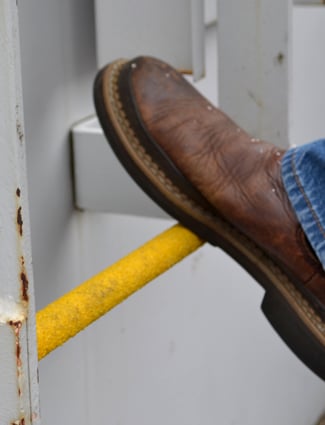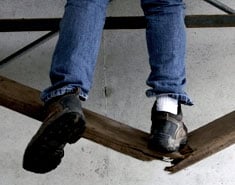Guidelines for OSHA's Fall Protection Standards & Compliance
03
February,
2023
5 MINUTE READ

Ineffective or missing fall protection has been OSHA's most-cited violation every year since 2011, and falls are the leading cause of death in the construction industry.
But these fall-related injuries and deaths are easily preventable, and OSHA's guidelines for fall protection outline a path to a safer workplace.
What are OSHA's Fall Protection Standards and Guidelines?
OSHA has established industry-specific requirements and tools to reduce the risks that come with working at elevated heights. Employers must provide safe, secure fall protection where workers are exposed to falls from the following heights:
- Four feet in general industry workplaces
- Five feet in shipyards
- Six feet in the construction industry
- Eight feet in longshore operations
OSHA also provides employers with other specific rules to address the hazards of falls, which include:
- Employees working on a surface with an unprotected side or edge that's six feet or more above a lower level must use fall protection (via guardrails, safety nets, or personal fall arrest systems)
- Fall protection must be provided (regardless of the potential fall distance) when employees work over dangerous equipment and machinery, such as conveyor belts or containers of hazardous liquids
- Exposed holes in the floor must be completely guarded, with a railing and toe board or with a cover
- Guardrails and toe boards must be used around open-sided platforms, floors, and runways
- Employers must train workers on height-related hazards, notify them of the dangers posed by working at heights, and how to remain safe on the job
What Does Effective Fall Protection Look Like?

Effective fall protection comes in two basic forms: fall restraint systems (such as rails or toe boards) to prevent employers from falling in the first place, and fall arrest systems (including harnesses or safety nets) to break an employee's fall.
Employers may consider some combination of the following:
- Guardrails and handrails
- Guardrails must include top rails, midrails, and posts, and must be 42 inches high
- Stair rails must be securely fastened to or mounted on a wall or partition, and be 30 to 34 inches above the surface
- Toe boards
- Use barriers at the base of a working area, and prevent tools from falling or employees' feet from slipping over an edge
- Must be at least four inches high, be securely fastened in place, and have no more than 1/4 inch clearance above floor level
- Full-body or chest harness
- Keeps an employee suspended in the event of a fall
- Body belts, which work in conjunction with harnesses, are not by themselves considered acceptable as part of a personal fall arrest system in the construction industry and should be used only for positioning.
- Safety net
- May be used up to a distance of 25 feet below the working surface
- Especially useful on construction sites
- Proper scaffolding
- When scaffolding is at least 10 feet above the lower level, a competent person must determine the feasibility and safety requirements for providing fall protection for employees building or dismantling scaffolds
- Scissor lifts are considered to be scaffolding and require fall protection when at least 10 feet off the ground; however, most scissor lifts are outfitted with guardrails, which satisfies OSHA's fall protection requirement
- When working on suspended scaffolding, employees must be tied to an anchor point or use a fall protection system that's not connected to the scaffold
- Duralabel has more detailed information on scaffolding safety and the hazards posed by improper scaffolding
- OSHA has more information on specific types of scaffolding and the fall protection required for each
- Training on fall protection and how to use it effectively
Fall Protection Requirements When Working on Ladders
A total of 5,190 workers were killed on the job in 2016; 849 of them died from falls. Of those, approximately 170 died from a fall off of a ladder, and falls of six feet or greater off of ladders are often fatal. The following requirements are designed to prevent these fatalities and other ladder-related injuries.

Requirements for all ladders: 29 CFR 1910.23 (Ladders-General)
- Ladder rungs must be between 10 and 14 inches apart. Exceptions:
- Stepstools
- Telecommunication ladders
- Manhole ladders
- Elevator pit ladders
- Objects being carried up a ladder should not throw off the balance of the climber.
- All ladders must be strong enough to support their established maximum intended load.
- Ladders should not be moved while in use.
- All ladder rungs must be parallel, even, level, and shaped in a way that a worker's feet cannot slide off of the rungs.
- Wooden ladders should be easy to inspect for damage, and inspected regularly.
- Metal ladders should be protected against corrosion and have a non-slip texture on the rungs.
- Ladders should have non-conductive side rails if used near electrical equipment.
- Damaged ladders should be labeled "DO NOT USE" and decommissioned or repaired.
- Single rail ladders are explicitly forbidden by both 1910.23 (General) 1926.1053 (Construction).
Fixed ladders
- The distance between a fixed ladder rung and back of a mounted object must be 7 inches with the exception of elevator pits, where the minimum is 4.5 inches.
- Ladders that are 24 ft. or longer must have one of the following safety devices:
- Self-retracting lifelines
- Rest platforms every 150 ft. or less
- Adjacent offset ladder sections with a platform every 50 ft.
- A cage or well
- Ladders must be able to sustain at least two loads of 250 pounds each, concentrated between any two consecutive rungs.
- Ladder side rails and grab bars should extend 42 inches past the top level of access where the ladder terminates.
- Ladders without cages or wells must have:
- A clear width of 15 inches on either side of the ladder's centerline to the nearest permanent object.
- A minimum perpendicular distance of 30 inches from the centerline of the rungs on the climbing side to the nearest permanent object.
Portable ladders
- The base of the ladder should be set no further than ? the ladder's height away from the wall.
- A barricade should be established to protect the ladder from moving if there is a chance it can be knocked off balance.
- Ladders should extend 3 ft. past the edge it is making contact with.
- Both side rails should be securely set against landing edge.
- The top step should not be used, unless specifically stated otherwise.
Fall Protection in the Construction Industry
Falls are the leading cause of death in the construction industry, but these are easily preventable. Numerous OSHA guidelines provide the framework for a safer construction site.
One key rule mandates that employers provide fall protection when an employee is working six feet or more above a lower level-or 10 feet when working on a scaffold.

The only exception to this rule is when an employer can demonstrate that such a system is infeasible or when the hazard is increased by using the system. In these cases, an employer must develop a fall protection plan specific to the site where the work is performed.
Other more specific rules in the construction industry include:
- Employees must be protected from falling through holes (including skylights) more than six feet above lower levels. This may be done through personal fall arrest systems, covers, or guardrail systems around the hole(s).
- Employees on the face of formwork or reinforcing steel must be protected from falling six feet or more to lower levels by personal fall arrest systems, safety nets, or other positioning device systems.
- Guardrails must protect employees on ramps, runways, and other walkways from falling six feet or more onto lower levels.
- Employees working near excavations, wells, pits, and shafts six feet or deeper must be protected from falling by guardrails, fences, barricades, covers, or other visual barriers.
- Employees working above dangerous equipment must be protected from falling.
- If the employee is less than six feet above the equipment, a guardrail systems or equipment guards must be used.
- If the employee is six feet or more above the dangerous equipment, guardrails, personal fall arrest systems, or safety nets must be used.
How Can Duralabel Help with Fall Protection?
Providing solutions for safety since 1970, Duralabel offers numerous resources for ensuring workers are free from on-the-job hazards.
We offer on-site Compliance Assessment Services that review your fall protection efforts, make recommendations for improving employee safety, and offer best practices for keeping workers safe.
DuraLabel industrial label and sign printers by Duralabel can assist in developing clear, custom visual communication that alerts employees to height-related dangers and provides necessary information for working at elevated heights. With a variety of printers and more than 50 specialty label supplies, you'll find the right tools to improve your facility's safety.
Lastly, we have provided you a free Guide to Preventing Slips, Trips, & Falls in your facility. Download your copy below.
RELATED RESOURCES

OSHA 29 CFR 1926
Construction is a high hazard industry, with unique situations and hazards, and it employs more than six ...
Read
Improving Job Site Safety with an Industrial Label Printer
OSHA reports that nearly 6.5 million workers are employed at approximately 252,000 construction job sites in ...
Read
OSHA Construction Site Compliance
OSHA construction compliance is a key element for maintaining a safe jobsite. According to OSHA, nearly 6.5 ...
Read.png)


